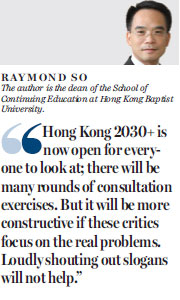Criticism of the HK2030+ must be fair and constructive
Updated: 2016-11-03 07:35
By Raymond So(HK Edition)
|
|||||||
Last week the government unveiled its vision and long-term strategy for urban development in the report "Hong Kong 2030+: Towards a Planning Vision and Strategy Transcending 2030". It sets out a planning framework for the future development of the city. It provides broad directions for land supply and town planning for a period beyond 2030. The most prominent aspect is, of course, land development. A prominent and significant feature of the planning strategy is to develop North New Territories and East Lantau Island. Like many initiatives by the government, Hong Kong 2030+ received instant criticism, with some questioning the need for development as well as insufficient consultation.
Needless to say, in this highly charged political environment, the government can easily attract criticism. But it is simply unfair to challenge Hong Kong 2030+ just because it was formulated by the government. Hong Kong 2030+ did not develop out of thin air; it is based on "Hong Kong 2030 Planning Vision and Strategy", a report produced in 2007. Development nowadays always considers the issue of sustainability. Also, Hong Kong 2030+ is now open for everyone to look at; there will be many rounds of consultation exercises. But it will be more constructive if these critics focus on the real problems. Loudly shouting out slogans will not help.

Hong Kong 2030+ mentioned the development of the North New Territories and touched explicitly on the issue of developing brownfield sites in the New Territories.
On one hand, it can be said that the government has the courage to discuss the thorny issue of brownfields, which has become a sensitive matter in the wake of the Wang Chau row. On the other hand, this also suggests there will be a long period of controversy surrounding the land development strategy.
It is necessary for the government to resume brownfield sites for development purposes. But this will involve compensation. We have to always remember that Hong Kong is a society ruled by law. So the government has to take into account the interests of the owners of brownfield sites when considering the resumption of brownfield land. If the brownfield sites are currently in use, there arises the big question of how to relocate the current users and how to compensate land owners. Given that current business operations on brownfield sites are mainly undesirable industries, it is not easy to find new sites for their relocation. The existing brownfield users will complain if they are forced out, and the neighbors of suggested alternative sites will raise objections to their moving-in. Therefore, it is likely that the amount of brownfield land that the government can reuse for development will be limited. If there are 10 hectares of brownfield land that the government can resume, most likely the development scale will have to be reduced because of various reasons and restrictions. This suggests the amount of brownfield land the government needs for housing development will be higher than that originally planned.
Also, the government mentioned in the new land development strategy there will not be any development plans for the Fanling golf course. It has explained that there are historical buildings, trees and graves in the golf course, which make it undesirable for development. But during discussions on the development of North East New Territories, some people mentioned the idea of reusing golf course land for housing development. While such ideas have now fallen out of favor, we should not totally rule out the possibility of doing this. In the end we may also conclude that the golf course site has little value when it comes to redevelopment. But ruling out such a possibility completely now will be perceived by many as being unfair. This will undoubtedly lead to criticism.
Hong Kong 2030+ is still at the stage of collecting views from the public. Clearly there will be a need to have more opinions on how to develop the North New Territories. Public participation in this major development project is an absolute must.
(HK Edition 11/03/2016 page9)